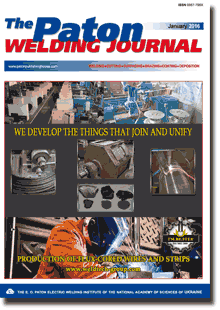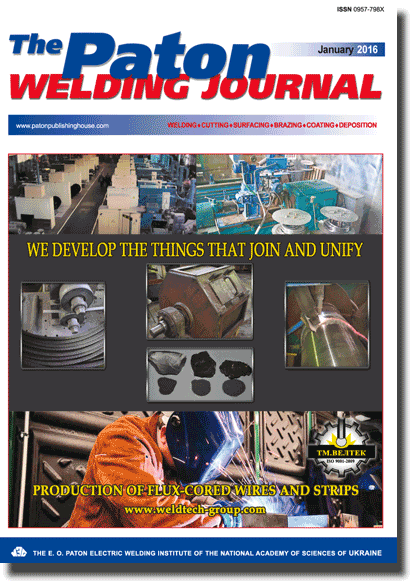| 2016 №01 (07) |
DOI of Article 10.15407/tpwj2016.01.08 |
2016 №01 (01) |

The Paton Welding Journal, 2016, #1, 49-51 pages
Mechanisms of formation of welding aerosol solid component and paths of its penetration into the living organism (Review)
I.P. Gubenya And I.R. Yavdoshchin
E.O. Paton Electric Welding Institute, NASU 11 Kazimir Malevich Str., 03680, Kiev, Ukraine. E-mail: office@paton.kiev.ua
Abstract
The paper presents a review of current state of the issue of studying the mechanism of welding aerosol (WA) formation, dispersity of welding aerosol solid component and its ability to penetrate into the human body, as an important toxicological factor. It is established that there exist two main mechanisms of WA formation — due to condensation of high-temperature evaporation products and due to formation of volatile oxides on molten metal surface. Here, the molten metal drop is the main evaporation source, but weld pool and metal spatter also participate in the evaporation process. It is known that penetrability depends, chiefly, on dimensions of particles and their agglomerates: the smaller their size, the higher the penetrability. In addition to the already known paths of WA particle penetration into the body through the respiratory tract and digestive organs, nanosized particles can penetrate directly into the brain through nerve endings in the sinuses, as well as penetrate into the blood-vascular and lymphatic systems. This results in their accumulation in the bone marrow, lymph nodes, spleen and heart. Issue of searching for the methods to lower the emissions in coated-electrode welding is still urgent, chiefly due to improvement of their coating composition, as well as the ability to control particle dispersity in WA. 25 Ref., 1 Figure.
Keywords: particle, welding aerosol, solid component, toxicity, penetrability, sanitary-hygienic characteristics
Received: 13.11.15
Published: 15.03.16
References
- Pokhodnya, I.K., Gorpenyuk, V.N., Milichenko, S.S. et al. (1990) Metallurgy of arc welding: Processes in arc and melting of electrodes. Ed. by I.K. Pokhodnya. Kiev: Naukova Dumka.
- IIW statement on manganese. https://app.aws.org/technical/iiw-manganese.pdf
- Clark, D. (2014) What the recent recommendation on manganese exposure means to you. Welding J., 93(8), 36–40.
- Jenkins, N., Moreton, J., Oakley, P. et al. (1981) Welding fume. Sources, characteristics, control, Vol. 1–2, 269–329. Cambridge: Abington Hall.
- Dennis, J.H., Hewitt, P.J., Redding, C.A.J. et al. (2001) A model for prediction of fume formation rate in gas metal arc welding (GMAW), globular and spray modes, DC electrode positive. Occup. Hyg., 45, 105–113. https://doi.org/10.1093/annhyg/45.2.105
- Erokhin, A.A. (1964) Kinetics of metallurgical processes of arc welding. Moscow: Mashinostroenie.
- Kobayashi, M., Maki, S., Hashimoto, Y. et al. (1978) Some consideration about the formation mechanisms of welding fume. Welding in the World, 16(11/12), 238–245.
- Leskov, G.I. (1970) Electric welding arc. Moscow: Mashinostroenie.
- Heile, R., Hill, D. (1975) Particulate fume generation in arc welding processes. Welding J., 7, 201–210.
- Voitkevich, V. (1995) Welding fumes: formation properties and biological effects. Cambridge: Abington p
- Jenkins, N.T., Pierce, W.M.G., Eagar, T.W. (2005) Particle size distribution of gas metal and flux cored arc welding fumes. Welding J., 84, 156–163.
- Sterjovski, Z., Drossier, J., de Thoisy, E. et al. (2006) An investigation of particulate weld fume generated from GMAW of plain carbon steel. Welding J., 51(1st quart.), 21–40.
- Berlinger, B., Benker, N., Weinbruch, S. et al. (2010) Physicochemical characterization of different welding aerosols Bioanal. Chemistry, 10, 1773–1780.
- Zimmer, A.E., Biswas, P. (2001) Characterization of the aerosols resulting from arc welding processes. Aerosol Sci., 32, 993–1008. https://doi.org/10.1016/S0021-8502(01)00035-0
- Zimmer, A.E. (2002) The influence of metallurgy on the formation of welding aerosols. Envir. Monitoring, 4, 628–632. https://doi.org/10.1039/B202337G
- Sterjovski, Z., Norrish, J., Monaghan, B.J. (2008) The effect of voltage and metal-transfer mode on particulate-fume size during the GMAW of plain-carbon steel: IIW Doc. VIII-2092–08.
- Sowards, J.W., Lippold, J.C., Dickinson, D.W. et al. (2008) Characterization procedure for the analysis of arc welding fume. Pt 1. Welding J., 87(4), 76–83.
- Sowards, J.W., Lippold, J.C., Dickinson, D.W. et al. (2008) Characterization of welding fume from SMAW electrodes. Ibid., 4, 106–112.
- Sowards, J.W., Lippold, J.C., Dickinson, D.W. et al. (2010) Characterization of welding fume from SMAW electrodes. Pt 2. Ibid., 89(4), 82–89.
- Jankovic, J. (2005) Searching for a relationship between manganese and welding and Parkinson’s disease. Neurology, 64, 2021–2028. https://doi.org/10.1212/01.WNL.0000166916.40902.63
- Demetskaya, A.V., Kucheruk, T.K., Movchan, V.A. (2006) Particles of nanorange: possible contribution to development of occupationally conditioned pathology. Zhurnal Probl. Med. Truda, 1, 62–67.
- Hoet, P.H.M., Brueske-Hohlfeld, I., Salata, O.V. (2004) Nanoparticles — known and unknown health risks. Nanobiotechnology, 12 (2), 15.
- Glushkova, A.V., Radilov, A.S., Rembovsky, V.R. (2007) Nanotechnologies and nanotoxicology: View of the problem. Vestnik, 6, 4–8.
- Raloff, J. (2010) Destination brain. News, 177(11), 16–20. https://doi.org/10.1002/scin.5591771120
- Oberdoster, G., Zharp, Z., Atudorei, V. et al. (2004) Translocation of inhaled ultrafine particles to the brain. Toxicology, 16, 437–445.
Suggested Citation
I.P. Gubenya And I.R. Yavdoshchin (2016) Mechanisms of formation of welding aerosol solid component and paths of its penetration into the living organism (Review). The Paton Welding J., 01, 49-51.The cost of subscription/purchase order journals or individual articles
| Journal/Currency | Annual Set | 1 issue printed |
1 issue |
one article |
| TPWJ/USD | 384 $ | 32 $ | 26 $ | 13 $ |
| TPWJ/EUR | 348 € | 29 € | 24 € | 12 € |
| TPWJ/UAH | 7200 UAH | 600 UAH | 600 UAH | 280 UAH |
| AS/UAH | 1800 UAH | 300 UAH | 300 UAH | 150 UAH |
| AS/USD | 192 $ | 32 $ | 26 $ | 13 $ |
| AS/EUR | 180 € | 30 € | 25 € | 12 € |
| SEM/UAH | 1200 UAH | 300 UAH | 300 UAH | 150 UAH |
| SEM/USD | 128 $ | 32 $ | 26 $ | 13 $ |
| SEM/EUR | 120 € | 30 € | 25 € | 12 € |
| TDNK/UAH | 1200 UAH | 300 UAH | 300 UAH | 150 UAH |
| TDNK/USD | 128 $ | 32 $ | 26 $ | 13 $ |
| TDNK/EUR | 120 € | 30 € | 25 € | 15 € |
AS = «Automatic Welding» - 6 issues per year;
TPWJ = «PATON WELDING JOURNAL» - 12 issues per year;
SEM = «Electrometallurgy Today» - 4 issues per year;
TDNK = «Technical Diagnostics and Non-Destructive Testing» - 4 issues per year.


